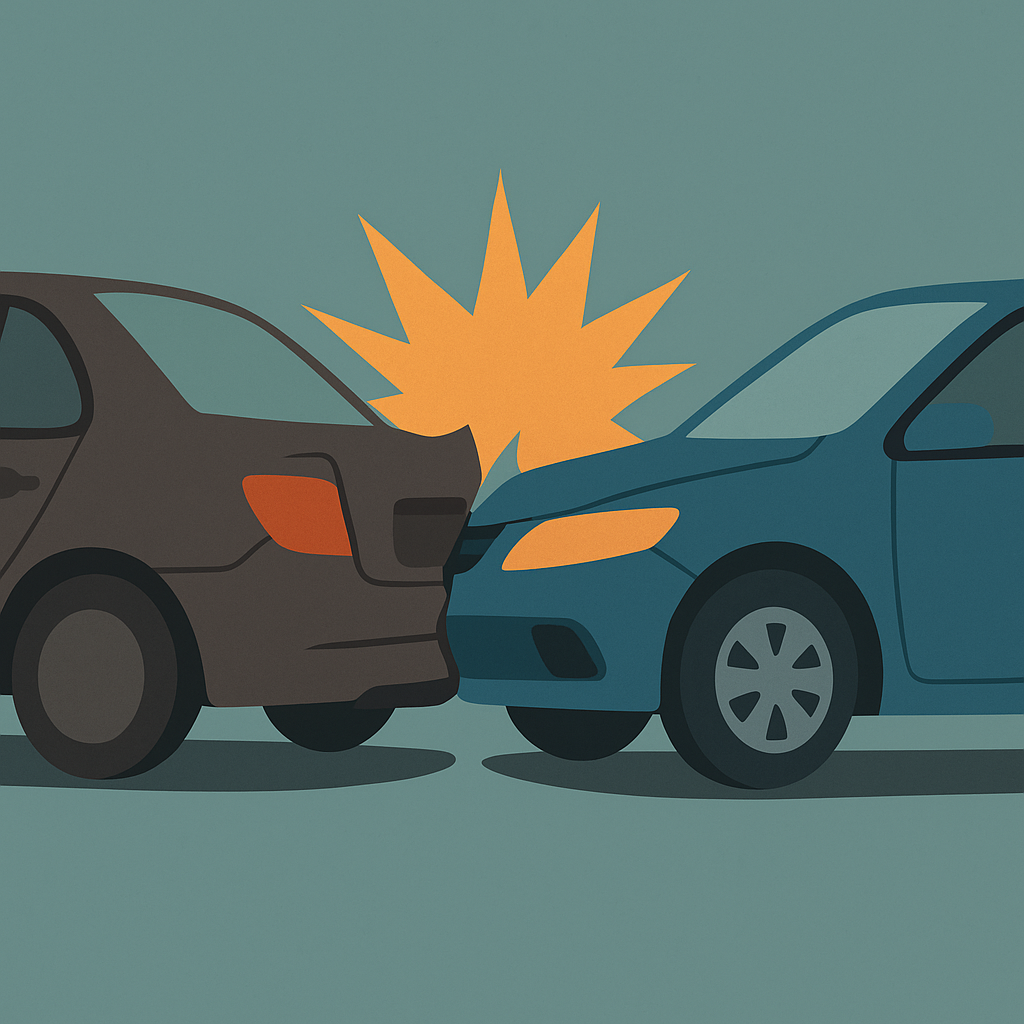Rear-end collisions happen unexpectedly but are alarmingly common, causing frustration and potential injury for countless drivers annually. Understanding the probability of rear end crash is crucial for drivers who have been affected by such incidents and are eager to grasp the underlying causes and potential routes for legal compensation.
In this article, we will delve into the causes of rear-end accidents, the likelihood of their occurrence, and the steps you can take if you find yourself involved in one. This exploration will help you not only navigate immediate concerns but also prepare for potential legal actions to secure your rightful compensation.
What is the Probability of Rear End Crashes?
Statistical Analysis of Rear-End Crashes
Rear-end collisions are alarmingly prevalent on roadways across the nation. Startling statistics from the National Highway Traffic Safety Administration (NHTSA) reveal that a staggering 28% of all traffic accidents stem from rear-end crashes. This sobering figure translates to an astonishing 2.5 million such incidents occurring annually on U.S. roads, underscoring the high probability of encountering rear-end crash risks while driving.
The leading culprit behind the majority of rear-end collisions is a startling lack of attentiveness on the part of drivers. Distracted driving, a concerning trend encompassing activities that divert a driver’s attention from the road, is cited as a contributing factor in a shocking 87% of these incidents. This statistic serves as a stark reminder of the paramount importance of maintaining unwavering focus while operating a vehicle.
One unique insight into the elevated risk of rear-end crashes is the prevalence of such incidents during stop-and-go traffic patterns. These conditions can lead to a heightened risk of mechanical failures or driver fatigue, factors that are often overlooked in typical analyses. Recognizing these potential hazards can prove invaluable in informing a driver’s approach to seeking legal counsel from a chicago car accident attorney or medical evaluations following an accident, potentially broadening the scope of compensation claims beyond immediate physical damages.
As a driver, it is crucial to be cognizant of the statistical realities surrounding rear-end collisions. This awareness can serve as a powerful tool in navigating the legal and healthcare landscapes should you find yourself a victim of such an incident. By understanding the sheer magnitude of the problem and the various contributing factors, you can better position yourself to seek the appropriate assistance and pursue just compensation.
Factors Affecting Rear End Collision Rates
Rear End Collision Rates:
Distracted driving is the leading cause of rear-end collisions, accounting for a staggering 87% of incidents. Drivers frequently become distracted by mobile devices, navigation systems, and passengers, significantly increasing the probability of these crashes on highways and local roads.
Road conditions, including poor pavement quality and unexpected obstacles, also contribute by forcing sudden braking, with drivers lacking sufficient response time. Aggressive driving behaviors like tailgating and speeding further escalate risks by reducing reaction times during unexpected stops.
Environmental factors like inclement weather and poor lighting can compound these issues by obscuring vision and hindering timely responses, especially when combined with negligent driving or suboptimal road conditions.
Common Causes of Rear End Accidents
Driver Error and Distraction
Rear-end collisions are among the most prevalent types of traffic accidents, and driver error coupled with distraction play pivotal roles in their occurrence. These two factors form the basis for a staggering majority of rear-end incidents. Alarmingly, approximately 87% of rear-end accidents are directly linked to the driver in the trailing vehicle being distracted. This statistic underscores the grave prevalence and consequences of distracted driving.
Distraction can manifest in various forms while behind the wheel. Using mobile phones, adjusting in-car entertainment systems, or even engaging in conversations can significantly impair a driver’s attention and reaction time, drastically increasing the probability of rear-end collisions. The National Highway Traffic Safety Administration (NHTSA) has also emphasized that many drivers fail to maintain a safe following distance, especially in urban areas where sudden stops are common.
Another factor contributing to rear-end collisions is the misapprehension of modern vehicle technology. Advanced Driver-Assistance Systems (ADAS), designed to enhance safety, can paradoxically create a false sense of security among some drivers. They may become complacent, assuming the vehicle will automatically manage speed or notify them of potential collisions. This misplaced trust in technology can lead to a lack of attentiveness and further exacerbate the risk of rear-end crashes.
Environmental and Road Conditions
Rain, snow, and fog contribute significantly to rear end collisions by reducing visibility and increasing stopping distances. Wet or icy roads can cause vehicles to skid, increasing the likelihood of rear end crashes, which are the most common type of collisions because drivers have less control over their vehicles.
Poorly maintained roads with potholes or surface irregularities can result in sudden braking or erratic driving behavior, raising the probability of rear end crash events. Roads with inadequate drainage can also lead to pooling water, further complicating vehicle control.
Unexpected obstacles, such as debris or wildlife, can force sudden stops. For example, debris on heavily trafficked roads might cause one driver to brake suddenly, resulting in a chain reaction of collisions. Ensuring proper road maintenance and signage can help mitigate these risks.
While much attention is given to poor weather and road conditions, sun glare is an often-overlooked factor. Sun glare can blind drivers momentarily, reducing reaction times and consequently increasing the risk of rear end collisions. Addressing such less-discussed environmental aspects is crucial in making informed decisions about potential compensation claims following rear-end incidents.
Vehicle Malfunctions
Rear end collisions are an unfortunate reality on our roads, often resulting from vehicle malfunctions that compromise a driver’s ability to control their vehicle effectively. Mechanical failures, such as faulty brakes, worn brake pads, or defective brake lights, can significantly impair a driver’s capacity to stop promptly, increasing the probability of rear end crash occurrences. In some cases, drivers may be unaware of these defective conditions until it’s too late, leaving them little time to react and prevent a collision.
Another critical factor contributing to rear end accidents is tire blowouts. A sudden loss of tire pressure can cause a vehicle to veer unexpectedly, making it challenging for the driver to maintain control and potentially leading to a rear end collision if they are unable to stop in time. Additionally, steering malfunctions can also play a role in these types of accidents, as a driver may struggle to maneuver their vehicle effectively, increasing the likelihood of colliding with the vehicle in front of them.
Maintaining the health of your vehicle is crucial in preventing rear end collisions. Regular maintenance checks and addressing any mechanical concerns promptly can help ensure your vehicle is in optimal condition and ready to respond to your inputs. Moreover, understanding your vehicle’s condition and addressing any defects can reinforce your legal standing should an accident occur, particularly if manufacturer defects are found to be the root cause, potentially shifting liability and opening avenues for pursuing legal compensation.
Legal Implications and Liability in Rear-End Collisions
Determining Fault in Rear-End Collisions
The rear-end collision is a prevalent occurrence on roads, often leading to the presumption that the trailing driver is at fault for failing to maintain a safe following distance. This assumption stems from the principle that drivers must be prepared to halt their vehicles safely if the vehicle ahead suddenly brakes. However, various factors, such as abrupt stops, defective brake lights, or adverse road conditions, can complicate this common assumption.
An in-depth analysis of rear-end accidents reveals that while the rear driver is typically deemed liable, nuances exist in determining fault. For instance, if the brake lights on the leading vehicle malfunction, it could potentially shift the liability towards the front driver. In such cases, the rear driver’s ability to react promptly becomes hindered, leading to a collision.
To navigate the intricate legal landscape following a rear-end accident, drivers who sustain injuries should meticulously document the scene. Gathering evidence such as photographs, eyewitness accounts, and any relevant details can bolster their legal stance and support their claims for rightful compensation.
Interestingly, in multi-vehicle pile-ups, the determination of liability can become even more complex. The sequence of impacts and the contributing factors for each collision play a crucial role in assessing the distribution of fault among the involved parties. Understanding these nuances can aid victims in pursuing fair compensation and navigating the often-complicated legal proceedings.
Rear-End Accidents and Insurance Claims
Rear end collisions carry significant financial implications, often resulting in increased insurance claims and premiums for those found at fault. Insurance companies view drivers responsible for such accidents as high-risk clients, leading to substantial rate hikes. Even drivers involved in a no-fault rear end crash might face premium adjustments due to the accident record on their driving history. Major insurers like Progressive acknowledge that an at-fault accident can drastically influence rates, potentially remaining a factor for up to five years.
For drivers seeking compensation following a rear end collision, meticulously documenting the scene and maintaining detailed records can be invaluable assets when negotiating with insurance adjusters. Interestingly, insurance providers might implement rate increases based on the probability of rear end crash involvements linked to specific vehicle models or traffic patterns. Grasping these dynamics empowers drivers with better negotiation leverage when addressing claims and reshaping their insurance strategies post-accident.
Rear end collisions are the most common type of crashes, making them a significant concern for insurance companies. By understanding the probability of rear end crashes and the factors contributing to their prevalence, drivers can proactively mitigate risks and potentially avoid substantial premium hikes. Maintaining a clean driving record and staying vigilant on the road can go a long way in minimizing the financial impact of these all-too-common collisions.
Steps to Take After a Rear End Crash
Immediate Actions Post-Accident
Rear end collisions can happen unexpectedly, leaving you in a state of confusion and uncertainty. However, taking the right steps immediately after the accident can help protect your well-being and legal rights. Here’s what you should do:
- Ensure Safety First: Assess the situation and move your vehicle to a safe location, such as the side of the road, to prevent further accidents or injuries if possible. Safety should be your top priority.
- Notify Authorities: Even if the injuries seem minor, call 911 to report the rear end collision. This will ensure that law enforcement and emergency medical services are dispatched to the scene, which is crucial for documenting the incident and providing necessary medical attention.
- Document Evidence: While waiting for the authorities to arrive, take photographs of the accident scene, including vehicle damages, road conditions, and any other relevant details. This documentation will be invaluable when dealing with insurance claims and determining the probability of rear end crash factors.
- Exchange Information: Obtain the contact and insurance details of the other driver involved in the rear end collision. Additionally, gather the contact information of any potential witnesses, as their testimonies could be valuable during the subsequent investigation.
- Seek Medical Attention: After leaving the accident scene, it’s essential to visit a healthcare professional to address any injuries that may not be immediately apparent. Some injuries common in rear end accidents can manifest hours or days later, impacting both your health and potential compensation claims.
By following these immediate steps, you’ll be better prepared to navigate the aftermath of a rear end collision, ensuring your safety, preserving crucial evidence, and protecting your legal rights.
Collecting Evidence and Documentation
Capturing evidence at the accident scene is crucial to establishing the causes and liability of rear-end collisions. By meticulously documenting the incident, you can strengthen your case and support your claims.
Here are some essential steps to take:
- Photograph Everything: Rear-end collisions can often result from inattentive driving, following too closely, or sudden braking. Capture detailed photos of the accident scene from multiple angles to illustrate the circumstances leading to the crash. Focus on vehicle damage, road conditions, skid marks, and any debris that may provide insights into the dynamics of the collision. This visual documentation supports claims when determining the primary cause.
- Secure Witness Statements: Eyewitness accounts can be invaluable in reconstructing the sequence of events. Collect contact details from any bystanders or other drivers who witnessed the accident, and note their observations. Their unbiased perspectives can help illustrate how the rear-end collision unfolded, especially if liability is disputed.
- Obtain Police Report: An official police report provides an impartial account of the accident details as observed by the responding officers. This report is often a critical piece of evidence during insurance or legal proceedings, lending credibility to your case.
- Record Environmental Conditions: Rear-end collisions can be influenced by external factors such as weather and lighting conditions. Note any relevant details about the environment at the time of the accident, as these factors can impact visibility, traction, and the overall probability of a rear-end crash occurring.
- Document Injuries and Medical Evaluations: If you or your passengers sustained injuries, capture images of any visible wounds or bruising, and keep detailed records of medical examinations and treatments. These documents support injury claims and highlight the accident’s impact on your health and well-being.
- Access Vehicle Data: Modern vehicles are equipped with event data recorders (EDRs), often referred to as “black boxes.” These devices store valuable data about vehicle speed, braking patterns, and other performance metrics leading up to the collision. Accessing this data can provide concrete evidence of mechanical performance and driver actions, offering unique insights into the causes of the rear-end crash.
By diligently gathering evidence and documentation at the accident scene, you can build a strong case and increase the likelihood of a favorable outcome when determining liability and seeking compensation for damages or injuries sustained in a rear-end collision.
Seeking Legal Compensation and Support
Finding the Right Legal Assistance
Rear-end collisions are all too common on our roads, often resulting in serious injuries and significant property damage. Securing the right Chicago car accident lawyer is crucial for protecting your rights and ensuring you receive fair compensation.
The first step is to conduct thorough research to identify law firms that specialize in handling car accident cases, particularly rear-end collisions. Personal recommendations and online directories like FindLaw can help you find experienced attorneys in your area.
When evaluating potential legal counsel, it’s essential to look for firms with a proven track record of successfully negotiating favorable settlements for their clients. Look for attorneys who have in-depth knowledge of local traffic laws and regulations, as these can play a significant role in determining liability and the outcome of your case.
It’s also important to choose a lawyer who is approachable, communicates clearly, and takes the time to explain the probability of rear-end crash outcomes and the various legal paths available to you.
An initial consultation with a prospective attorney is often offered at no cost, providing an opportunity to discuss the details of your case and assess their level of expertise and commitment to your cause. This consultation can also help you gauge the attorney’s level of confidence in pursuing your claim and their willingness to go the extra mile to ensure a favorable outcome.
By taking the time to carefully research and select the right legal representation, you can increase your chances of a successful claim and navigate the often-complex process of seeking compensation with the support and guidance you need. Remember, having an experienced and dedicated legal team on your side can make all the difference in the aftermath of a rear-end collision.
Quick Take Aways
- Prevalence of Rear-End Collisions: Rear-end collisions account for a staggering 28% of all traffic accidents, with around 2.5 million incidents annually on U.S. roads, highlighting a significant risk for drivers.
- Leading Causes: Distracted driving is a major factor, contributing to an alarming 87% of rear-end crashes. Such distractions often stem from mobile device usage or in-car activities, emphasizing the importance of focused driving.
- Environmental Influences: Poor weather conditions and inadequate road maintenance can exacerbate the likelihood of rear-end collisions, reducing vehicle control and increasing the need for driver attentiveness.
- Legal Complications: Determining fault in rear-end collisions can be complex, particularly if mechanical failures or sudden stops are involved, which might shift liability considerations.
- Insurance Impacts: These accidents often result in increased insurance premiums for the at-fault party and could affect no-fault drivers based on the accident history recorded.
- Post-Accident Protocols: Essential steps include ensuring safety, notifying authorities, documenting the scene, and seeking medical attention to support any future claims and compensation efforts.
- Securing Legal Support: Finding experienced legal representation is crucial for navigating claims effectively, especially those specializing in rear-end collision cases, to ensure informed and robust advocacy in pursuit of compensation.
Frequently Asked Questions
- What factors increase the probability of a rear-end crash?
The probability of a rear-end crash increases due to factors like tailgating, sudden stops, distracted driving, and adverse weather conditions. Other elements such as road conditions and speeding also contribute significantly to the likelihood of such accidents.
- How can I reduce the probability of a rear-end collision?
To reduce the probability of a rear-end collision, maintain a safe following distance, stay alert, and avoid distractions. Employ defensive driving techniques and ensure your vehicle’s brake lights are functioning correctly to alert drivers behind you.
- What role does technology play in reducing the rear-end collision probability?
Advanced technologies like automatic emergency braking and adaptive cruise control play a crucial role in reducing rear-end collision probability. These systems help maintain safe distances and react more quickly to potential threats than human drivers.
- Are certain drivers more likely to be involved in rear-end collisions?
Younger and inexperienced drivers, as well as those prone to aggressive driving behaviors, are statistically more likely to be involved in rear-end collisions. These drivers may not accurately judge safe following distances or react in time to sudden stops.
- What is the probability of a rear-end crash in urban areas compared to rural areas?
The probability of a rear-end crash is generally higher in urban areas due to denser traffic conditions, more frequent stops, and a greater likelihood of distracted driving. Rural areas, with less traffic density, usually present lower chances for rear-end collisions.
Rear-End Collision? Don’t Let the Insurance Company Decide Your Future, Contact Ori Law Group Today
Rear-end collisions remain a prevalent hazard on the nation’s roadways, contributing significantly to the overall statistics of traffic accidents. The overwhelming majority of these incidents are largely influenced by distracted driving, a factor that underscores the need for drivers to maintain diligent focus at all times. Environmental conditions, such as adverse weather and defective road surfaces, further compound the risks, demanding heightened awareness and caution from all drivers.
Don’t leave your future in the hands of an insurance adjuster—call Ori Law Group at (312) 621-0000 to schedule a consultation with an experienced Chicago car accident attorney.
Beyond understanding the causes, the financial and legal implications of rear-end collisions cannot be understated. The impact on insurance claims and premiums can be substantial, making it imperative for drivers to be well-prepared to document and report every detail of an accident. Moreover, identifying the right legal assistance is crucial for anyone involved in a rear-end collision. Expert legal guidance not only aids in navigating the complex processes of compensation claims but is essential for ensuring that drivers receive the justice and recompense they deserve.
To this end, drivers should remain vigilant and proactive in minimizing the risk of rear-end collisions by being informed and prepared. By thoroughly documenting accident scenes, understanding the nuances of liability and compensation, and selecting competent legal representation, you fortify your position in the face of such incidents. If you have been injured in a rear-end collision, we urge you to take immediate action – reach out for a legal consultation, safeguard your interests, and ensure that your rights are fully protected. Remember, being informed is your best defense against the unforeseen challenges that rear-end collisions may present.
References
National Highway Traffic Safety Administration (NHTSA). (2007). Traffic Safety Facts 2005: A Compilation of Motor Vehicle Crash Data from the Fatality Analysis Reporting System and the General Estimates System. DOT HS 810 631. Washington, DC.
Insurance Information Institute. (2023). Facts + Statistics: Highway safety.
National Safety Council (NSC). (2022). Injury Facts: Motor Vehicle Safety Issues.
Federal Highway Administration (FHWA). (2020). Rear-End Crashes: Problem Size Assessment and Statistical Description.
Singh, S. (2015). Critical Reasons for Crashes Investigated in the National Motor Vehicle Crash Causation Survey. National Highway Traffic Safety Administration. DOT HS 812 115.










